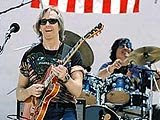These scales (called "pentatonic," meaning 5 note) are the most popular scales for guitar players -- bar none. Why? Several reasons:
1) They sound good. The "skipped" notes add an open, interesting sound that makes them pleasing to the ear.
2) They're versatile. Blues, rock, jazz, country . . . pentatonic scales work for so many different styles of music that it's ridiculous. They may be used in different ways, but it's the same 5 notes!
3) They're familiar. Guitarists as different as Jimmy Page (Led Zeppelin), John McLaughlin (Mahavishnu Orchestra, jazz rock), Jimi Hendrix, Slash (Guns & Roses), Kenny Burrell (jazz), Vince Gill (country), Neal Schon (Journey), Carlos Santana, Eric Clapton, Eric Johnson, Eddie Van Halen, Jeff Beck. The list goes on. They all use pentatonic scales for an enormous amount of their playing.
4) You can put your stamp on them. The way that Jeff Beck (one of the most unique players around, in my opinion) uses those 5 notes is totally different from the way the guitar players in Lynyrd Skynyrd did, and thus they sound totally different.
So, let's talk about the Pentatonic a little. There are generally two "modes" of Pentatonic: major and minor. (They're the same scale, but based around a different tonic chord, or "home" chord). Let's use Am as an example. The notes are:
A - C - D - E - G
If the harmony (chord progression) is in Am, then that scale works perfectly. Here are two different progressions you could try:
1) Am - C - D - D
2) Am - G - F - E7
(You could also use a 12-bar blues, in A)
If the harmony is in C (major), then the scale still works perfectly, although it sounds totally different. Here's a progression to try:
C - F - G - C
There are other keys this will work in, but those are the two most common.
Thursday, November 6, 2008
Subscribe to:
Post Comments (Atom)


No comments:
Post a Comment